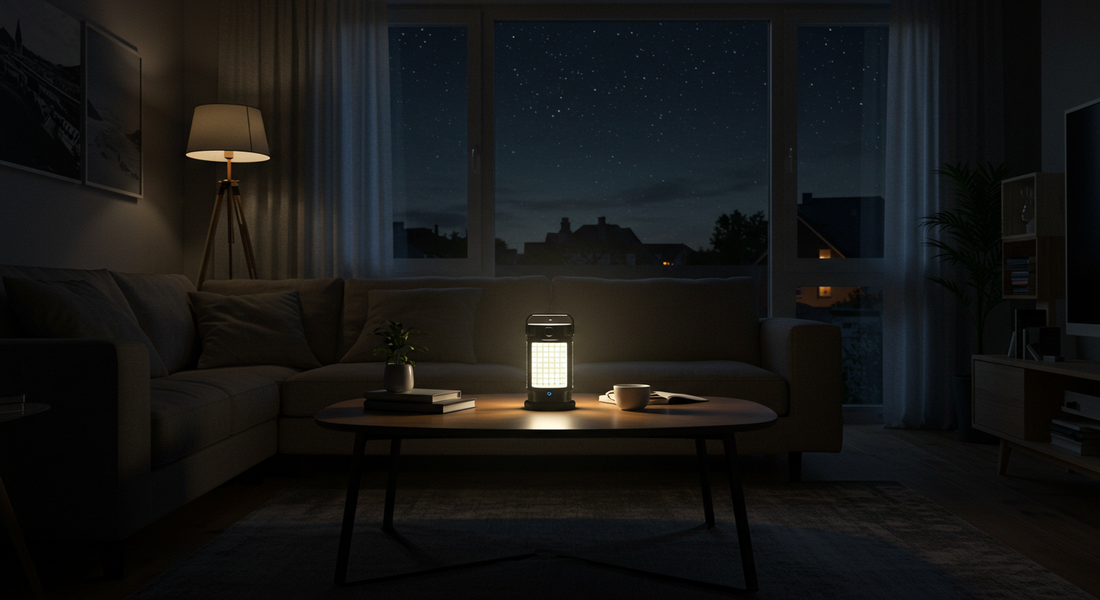
Surviving the Blackout: Your Ultimate Guide to Power Outage Essentials
Share
In our hyper-connected world, a power outage is one of the most common disasters we can face. What often starts as an inconvenience can quickly become a genuine emergency, especially during prolonged blackouts. Understanding what to do in a power outage is a fundamental aspect of modern home safety. Effective blackout preparedness moves you from a position of vulnerability to one of control. This guide details the absolute power outage essentials, providing a clear roadmap to creating a home blackout kit that will keep you and your family safe and comfortable when the lights go out.

The Top 10 Power Outage Essentials
A well-curated collection of emergency items is the cornerstone of blackout preparedness. These ten categories cover your core needs: light, power, information, food, water, safety, and well-being.
1. Reliable Lighting: LED Lanterns and Headlamps
The first challenge in a blackout is darkness. While tempting, candles are a significant fire hazard and should be avoided. Modern LED technology is the superior choice for emergency lighting due to its incredible energy efficiency and low heat output, making it safe for extended use. An LED lantern can illuminate an entire room, while a headlamp is invaluable for providing hands-free light for tasks like checking a circuit breaker or navigating your home.
2. Emergency Power: Power Station or Power Bank
In a blackout, your smartphone is your lifeline. A reliable backup power source is critical for communication. For most situations, a high-capacity power bank (20,000mAh or more) is enough to recharge phones and tablets multiple times. For greater preparedness, a portable power station offers standard AC outlets to run larger devices like laptops, lamps, or even small medical equipment.
3. Information: NOAA Hand-Crank Weather Radio
When Wi-Fi and cellular networks fail, an emergency radio is your most reliable link to vital information. The best models are powered by a hand crank, solar panel, and batteries, ensuring they work in any situation. Critically, look for one with the NOAA Weather Band, which provides direct access to official alerts about storms and other emergencies.
4. Off-Grid Cooking: Camping Stove and Fuel
A prolonged outage renders your kitchen appliances useless. A simple, single-burner propane or butane camping stove allows you to heat water and cook food, which can be a massive morale booster. Safety is paramount: Never use a camping stove indoors. They produce deadly carbon monoxide gas. Only operate them outdoors in a well-ventilated area.
5. Water: Stored Water and a Filtration Method
A power outage can compromise municipal water supplies. Never assume your tap water is safe. The standard recommendation is to store at least one gallon of water per person, per day, for a minimum of three days. Commercially bottled water is the safest option. As a backup, a reliable water filter can make questionable water sources safe to drink.
6. Food: A No-Cook, Non-Perishable Food Supply
Your refrigerator is only cold for a few hours during an outage. A well-stocked pantry with non-perishable foods that require no cooking is a core component of any home blackout kit. Focus on high-calorie items like protein bars, canned tuna or chicken, peanut butter, dried fruit, nuts, and crackers.

7. Warmth/Cooling: Wool Blankets or Battery-Operated Fans
An outage can leave you vulnerable to extreme temperatures. For cold weather, wool blankets are superior insulators, and layering clothing is highly effective. Mylar "space blankets" are an excellent, lightweight addition to any kit. In hot weather, a battery-operated fan provides critical air circulation, but staying hydrated is your most important defense.
8. First Aid & Sanitation
Minor injuries can become major problems without access to supplies. Ensure you have a comprehensive first-aid kit. Crucially, you must also have at least a one-week supply of any essential prescription medications. Don't forget sanitation supplies like wet wipes, hand sanitizer, and garbage bags.
9. Entertainment: Books, Cards, and Board Games
Preparedness is also about mental well-being. The sudden loss of electronic entertainment can lead to boredom and anxiety. Stocking your kit with non-digital items like cards, board games, or books can help pass the time, reduce stress, and create a welcome sense of normalcy.
10. A Carbon Monoxide Detector
This is a non-negotiable safety device. If you plan to use any alternative heating or cooking source that involves combustion (like a generator or camp stove), you must have a working, battery-powered carbon monoxide (CO) detector. CO is an invisible, odorless gas that can be fatal.
Power Outage Safety Tips
Food Safety
Keep refrigerator and freezer doors closed. A fridge will keep food safe for about 4 hours; a full freezer for about 48 hours. Any perishable food that has been above 40°F (4°C) for two hours or more should be discarded. When in doubt, throw it out.
Generator Safety Protocols
A portable generator can be a lifesaver, but it must be used correctly.
-
NEVER run a generator inside your home or garage.
-
ALWAYS place the generator outdoors, at least 20 feet away from doors and windows, to prevent exhaust fumes from entering your home.
-
NEVER try to "backfeed" power by plugging the generator into a wall outlet. This is extremely dangerous and can electrocute utility workers.
Conclusion: Building Your "Blackout Box" for Peace of Mind
The best way to prepare is to assemble a dedicated "Blackout Box." Choose a large, durable tote and store all your essentials inside. Keep this home blackout kit in an easily accessible location, like a closet or garage. Review and refresh your kit twice a year—when you change your clocks is a good reminder to check expiration dates and test batteries. This simple habit ensures your kit is always ready. Blackout preparedness is an investment in your family's safety and comfort, transforming a stressful event into a manageable situation and providing the ultimate peace of mind.
